Stretching Without Leaving Home: the Essentials
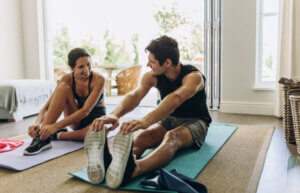
For athletes and people who exercise regularly, it’s very important to find a certain balance in the planning of workouts. Stretches are a fundamental part of this desired balance. That’s why it’s so important to have stretching routines that you can perform without leaving home.
In today’s article, we’ll discover what stretching consists of, and analyze its importance in sports planning. We’ll also check out a series of stretching exercises that you can do without leaving home and without the need for any equipment.
What is stretching?
Stretching is a physical activity that consists of movements that elongate the muscles. You can perform before and after an intense training session.
The goal of this activity is none other than to extend the muscles involved, in order to increase their flexibility. If we include this practice during our warm-up routine, it’s important to perform it after doing a series of joint mobility exercises. We should never do it during the first part of a session.
On the contrary, if we do stretching exercises after completing a workout, the goal will be to help the muscles regain their natural state after intense activity. Stretching also has a great preventive capacity, as it can help reduce the athlete’s injury index if performed correctly (Gremion, 2005).
The importance of breathing
One of the fundamental components of stretching is having mastery and control over our breathing. Being aware of the way that we breathe helps to make our movements more fluid. Besides that, stretching should be a pleasant activity that never causes pain, as we’ll see below.

Key tips for stretching without leaving home
First of all, it’s important to note that each stretching session shouldn’t last more than 25 minutes; even 20 minutes would be enough. You should always try to ensure a calm and relaxing environment. The key tips for this training method are as follows:
- Focus on maintaining good movement control. As we mentioned above, we should ideally spend 20 minutes stretching, maintaining every movement for approximately 20-30 seconds. Avoid making sudden movements, since a very rapid elongation of the muscles can cause injuries. On top of that, performing static stretches will make it easier for you to increase the range of motion, as Kevin Power points out in one of his research documents (Power, Behm, Cahill, Carroll & Young, 2004).
- Having good posture control. Maintaining a good body posture during a stretching routine is fundamental to reduce the risk of suffering an injury. It’s essential to keep your shoulders relaxed and always look straight forward, as well as trying to maintain a neutral position of the pelvis.
- Avoid reaching the threshold of pain. You shouldn’t feel any pain when stretching. There needs to be enough resistance to achieve the goal of muscle elongation, but it should never cause pain.
What stretching exercises can we do without leaving home?
In the following paragraphs, you’ll find a series of very simple exercises that you can do without leaving home. And the best part is that they don’t require any extra equipment.
- Start in a standing position, with your legs open. Then, breathe in as you lift and stretch your arms. Let the air out while you bring your arms back down and relax.
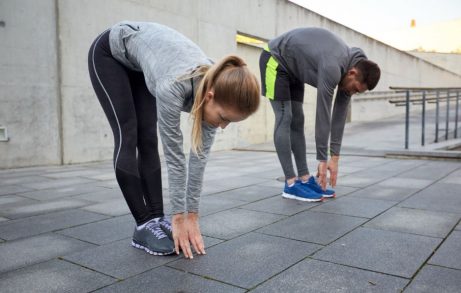
- Then, sit on a mat and hold your ankle with one hand, and the outside of your leg with the other. Hold this position for the time we estimated above.
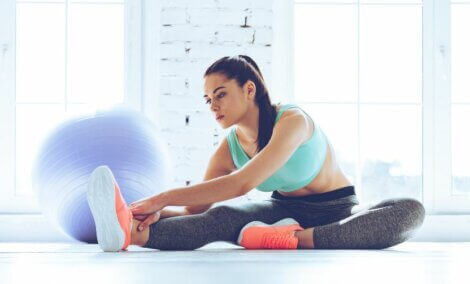
- For the next movement, remain seated. Stretch your arms as much as you can and keep them in this position, as straight as possible.
- For the next exercise, lie on your back with your knees bent. Then, lift up one leg and place it on top of the other, pushing it towards the ground.
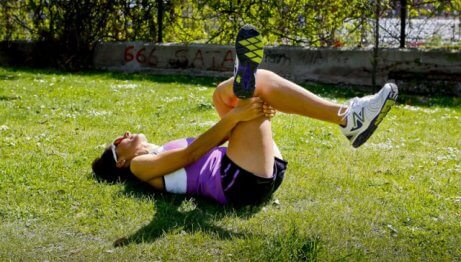
- It’s also very important to stretch the abdominal belt or core. To do this, lie face down on a mat. Subsequently, lift up your core very slowly, maintaining that position.
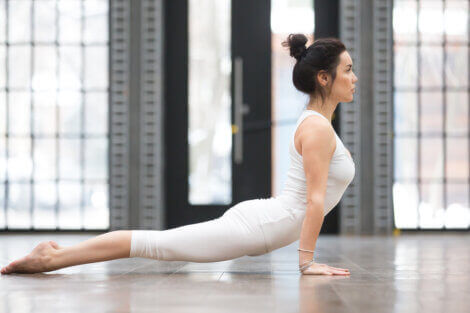
- To finish off the routine, stand up again. Grab your right leg while flexing back your knee and make sure to keep your balance at all times. Repeat the same step with your other leg.

The routine we just explained will not take more than 15 minutes, and it can be a great tool to get started on this practice. It’s important to remember that you should always start with very simple exercises and then progress to the more complex ones.
An ideal activity to be active
As you’ve seen, stretching is a very simple activity that we should include in all training programs. There are several stretching exercises that you can perform, it all depends on the muscles you will be using during the training session.
If you want the routine to be effective, follow all the tips we explained in this article. Remember that it’s essential to avoid any type of pain while doing this activity.
For athletes and people who exercise regularly, it’s very important to find a certain balance in the planning of workouts. Stretches are a fundamental part of this desired balance. That’s why it’s so important to have stretching routines that you can perform without leaving home.
In today’s article, we’ll discover what stretching consists of, and analyze its importance in sports planning. We’ll also check out a series of stretching exercises that you can do without leaving home and without the need for any equipment.
What is stretching?
Stretching is a physical activity that consists of movements that elongate the muscles. You can perform before and after an intense training session.
The goal of this activity is none other than to extend the muscles involved, in order to increase their flexibility. If we include this practice during our warm-up routine, it’s important to perform it after doing a series of joint mobility exercises. We should never do it during the first part of a session.
On the contrary, if we do stretching exercises after completing a workout, the goal will be to help the muscles regain their natural state after intense activity. Stretching also has a great preventive capacity, as it can help reduce the athlete’s injury index if performed correctly (Gremion, 2005).
The importance of breathing
One of the fundamental components of stretching is having mastery and control over our breathing. Being aware of the way that we breathe helps to make our movements more fluid. Besides that, stretching should be a pleasant activity that never causes pain, as we’ll see below.

Key tips for stretching without leaving home
First of all, it’s important to note that each stretching session shouldn’t last more than 25 minutes; even 20 minutes would be enough. You should always try to ensure a calm and relaxing environment. The key tips for this training method are as follows:
- Focus on maintaining good movement control. As we mentioned above, we should ideally spend 20 minutes stretching, maintaining every movement for approximately 20-30 seconds. Avoid making sudden movements, since a very rapid elongation of the muscles can cause injuries. On top of that, performing static stretches will make it easier for you to increase the range of motion, as Kevin Power points out in one of his research documents (Power, Behm, Cahill, Carroll & Young, 2004).
- Having good posture control. Maintaining a good body posture during a stretching routine is fundamental to reduce the risk of suffering an injury. It’s essential to keep your shoulders relaxed and always look straight forward, as well as trying to maintain a neutral position of the pelvis.
- Avoid reaching the threshold of pain. You shouldn’t feel any pain when stretching. There needs to be enough resistance to achieve the goal of muscle elongation, but it should never cause pain.
What stretching exercises can we do without leaving home?
In the following paragraphs, you’ll find a series of very simple exercises that you can do without leaving home. And the best part is that they don’t require any extra equipment.
- Start in a standing position, with your legs open. Then, breathe in as you lift and stretch your arms. Let the air out while you bring your arms back down and relax.

- Then, sit on a mat and hold your ankle with one hand, and the outside of your leg with the other. Hold this position for the time we estimated above.

- For the next movement, remain seated. Stretch your arms as much as you can and keep them in this position, as straight as possible.
- For the next exercise, lie on your back with your knees bent. Then, lift up one leg and place it on top of the other, pushing it towards the ground.

- It’s also very important to stretch the abdominal belt or core. To do this, lie face down on a mat. Subsequently, lift up your core very slowly, maintaining that position.

- To finish off the routine, stand up again. Grab your right leg while flexing back your knee and make sure to keep your balance at all times. Repeat the same step with your other leg.

The routine we just explained will not take more than 15 minutes, and it can be a great tool to get started on this practice. It’s important to remember that you should always start with very simple exercises and then progress to the more complex ones.
An ideal activity to be active
As you’ve seen, stretching is a very simple activity that we should include in all training programs. There are several stretching exercises that you can perform, it all depends on the muscles you will be using during the training session.
If you want the routine to be effective, follow all the tips we explained in this article. Remember that it’s essential to avoid any type of pain while doing this activity.
All cited sources were thoroughly reviewed by our team to ensure their quality, reliability, currency, and validity. The bibliography of this article was considered reliable and of academic or scientific accuracy.
- Gremion, G. (2005). The effect of stretching on sports performance and the risk of sports injury: A review of the literature. Schweiz Z Med Traumatol, 53(1), 6-10.
- Power, K., Behm, D., Cahill, F., Carroll, M., & Young, W. (2004). An acute bout of static stretching: Effects on force and jumping performance. Medicine & Science in Sports & Exercise 36, 1389–1396.
This text is provided for informational purposes only and does not replace consultation with a professional. If in doubt, consult your specialist.








